

Cosmos. With Cosmos, Carl Sagan and his wife and co-writer, Ann Druyan, brilliantly illustrated the underlying science of his same-titled book, placing the human species within a space-and-time context that brought the infinite into stunningly clear view.

The series, which originally aired in 1980 on PBS, has been seen by more than 700 million people worldwide and remains a high-water mark in miniseries history. Sagan lucidly explains such topics as Einstein's theory of relativity, Darwin's theory of evolution, and the greenhouse effect, bringing the mysteries of the universe down to a layman’s level of understanding. The footage in these remastered, seven-DVD or seven-VHS sets is as fresh and riveting as it was two decades ago and is certain to fire the imaginations of a whole new generation of viewers. This is THE GREATEST television series ever. Pale Blue Dot: A Vision of the Human Future in Space. The earth is a very small stage in a vast cosmic arena.
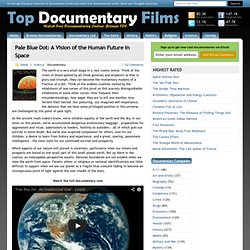
Think of the rivers of blood spilled by all those generals and emperors so that in glory and triumph, they can become the momentary masters of a fraction of a dot. Think of the endless cruelties visited by the inhabitants of one corner of this pixel on this scarcely distinguishable inhabitants of some other corner. The Pleasure of Finding Things Out. The Pleasure of Finding Things Out was filmed in 1981 and will delight and inspire anyone who would like to share something of the joys of scientific discovery.
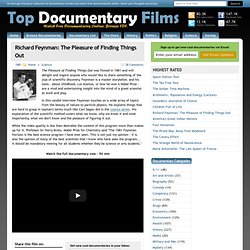
Feynman is a master storyteller, and his tales - about childhood, Los Alamos, or how he won a Nobel Prize - are a vivid and entertaining insight into the mind of a great scientist at work and play. In this candid interview Feynman touches on a wide array of topics from the beauty of nature to particle physics. He explains things that are hard to grasp in layman's terms much like Carl Sagan did in the cosmos series. ATOM. The discovery that everything is made from atoms has been referred to as the greatest scientific breakthrough in history.
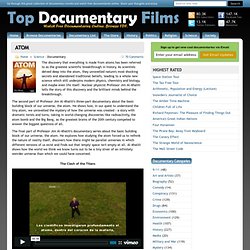
As scientists delved deep into the atom, they unravelled nature's most shocking secrets and abandoned traditional beliefs, leading to a whole new science which still underpins modern physics, chemistry and biology, and maybe even life itself. Nuclear physicist Professor Jim Al-Khalili tells the story of this discovery and the brilliant minds behind the breakthrough. The second part of Professor Jim Al-Khalili's three-part documentary about the basic building block of our universe, the atom. He shows how, in our quest to understand the tiny atom, we unravelled the mystery of how the universe was created - a story with dramatic twists and turns, taking in world-changing discoveries like radioactivity, the atom bomb and the Big Bang, as the greatest brains of the 20th century competed to answer the biggest questions of all.
The Clash of the Titans. The Moon, the Tides and Neil DeGrasse Tyson. Wonders of the Universe. Professor Brian Cox reveals how the most fundamental scientific principles and laws explain not only the story of the universe, but the story of us all.
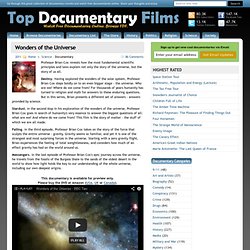
Destiny. Having explored the wonders of the solar system, Professor Brian Cox steps boldly on to an even bigger stage - the universe. Into The Universe With Stephen Hawking. Stephen Hawking hosts an epic brand new kind of cosmology series, a Planet Earth of the heavens.
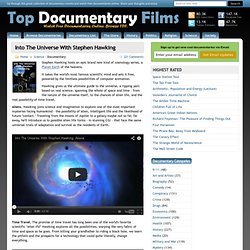
It takes the world's most famous scientific mind and sets it free, powered by the limitless possibilities of computer animation. Hawking gives us the ultimate guide to the universe, a ripping yarn based on real science, spanning the whole of space and time - from the nature of the universe itself, to the chances of alien life, and the real possibility of time travel. Aliens. Hawking joins science and imagination to explore one of the most important mysteries facing humankind - the possibility of alien, intelligent life and the likelihood of future "contact. " Traveling from the moons of Jupiter to a galaxy maybe not so far, far away, he'll introduce us to possible alien life forms - in stunning CGI - that face the same universal trials of adaptation and survival as the residents of Earth. Universe: The Cosmology Quest.
Most of us are intrigued by questions to do with the origin and evolution of the universe.
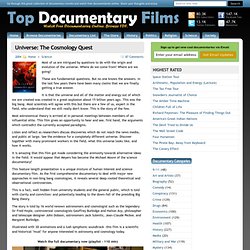
Where do we come from? Where are we going? These are fundamental questions. Neil deGrasse Tyson: Called by the Universe (Conversation) Neil deGrasse Tyson is the Frederick P.
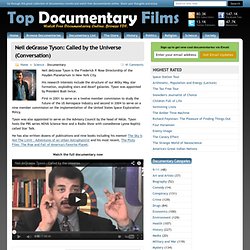
Rose Directorship of the Hayden Planetarium in New York City. His research interests include the structure of our Milky Way, star formation, exploding stars and dwarf galaxies. Stephen Hawking’s Universe. Stephen Hawking's Universe is an astronomical documentary from 1997 made for the Public Broadcasting Service featuring the theoretical physicist Stephen Hawking.
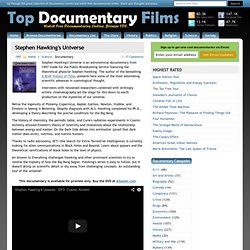
The author of the bestselling A Brief History of Time, presents here some of the most astonishing scientific advances in cosmological thought. Interviews with renowned researchers combined with strikingly artistic cinematography set the stage for this down-to-earth production on the mysteries of our universe. Relive the ingenuity of Ptolemy, Copernicus, Kepler, Galileo, Newton, Hubble, and Einstein in Seeing Is Believing. Despite diagnosis with ALS, Hawking completed his Ph.D., developing a theory describing the precise conditions for the Big Bang. The history of chemistry, the periodic table, and Curie's radiation experiments in Cosmic Alchemy allowed Einstein's theory of relativity and revelations about the relationship between energy and matter. Do We Really Need the Moon? The Story of Science: Power, Proof and Passion. For thousands of years we have wrestled with the great questions of existence.
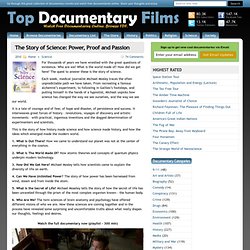
Who are we? What is the world made of? How did we get here? The Hawking Paradox. Stephen Hawking is the most famous scientist on the planet. His popular science book A Brief History of Time was a publishing sensation, staying at the top of the bestseller lists longer than any other book in recent history. But behind the public face lies an argument that has been raging for almost 30 years. Richard Feynman: The Character of Physical Law. Absolute Zero. The Big Bang. Supermassive Black Holes. In June 2000, astronomers made an extraordinary discovery. One that promises to solve one of the biggest problems in cosmology – how and why galaxies are created.
Incredibly, the answer involves the most weird, destructive and terrifying objects in the Universe – supermassive black holes. Scientists are beginning to believe that these forces of pure destruction actually help trigger the birth of galaxies and therefore are at the heart of the creation of stars, planets and all life. Exactly how our galaxy was created has mystified astronomers and physicists for years.
Although there have been many theories, there’s little evidence to explain how the gas in the early Universe condensed to form the galaxy we see today. The supermassive black hole in our own galaxy may be the reason we exist, but recent work suggests it may also be our end. Brian Cox on CERN's supercollider. Can We Make a Star on Earth? Professor Brian Cox takes a global journey in search of the energy source of the future. Called nuclear fusion, it is the process that fuels the sun and every other star in the universe. Yet despite over five decades of effort, scientists have been unable to get even a single watt of fusion electricity onto the grid.
Brian returns to Horizon to find out why. Granted extraordinary access to the biggest and most ambitious fusion experiments on the planet, Brian travels to the USA to see a high security fusion bomb testing facility in action and is given a tour of the world's most powerful laser. In South Korea, he clambers inside the reaction chamber of K-Star, the world's first super-cooled, super-conducting fusion reactor where the fate of future fusion research will be decided.
Nuclear fusion is nature's power source. The Big Bang Machine. Professor Brian Cox visits Geneva to take a look around Cern's Large Hadron Collider before this vast, 27km long machine is sealed off and a simulation experiment begins to try and create the conditions that existed just a billionth of a second after the Big Bang. Cox joins the scientists who hope that the LHC will change our understanding of the early universe and solve some of its mysteries. News: Not to be thwarted by a few annoying speed bumps on the road to discovery, CERN scientists have successfully slammed accelerated protons together inside the giant Large Hadron Collider (LHC) in order to re-create conditions within the universe just moments after the Big Bang. "This opens the door to a totally new era of discovery,” enthused CERN's director of research Sergio Bertolucci via a video relay from the LHC facility. “It is a step into the unknown where we will find things we thought were there and perhaps things we didn't know existed.
" Do You Know What Time It Is? Particle physicist Professor Brian Cox asks, 'What time is it? ' It's a simple question and it sounds like it has a simple answer. But do we really know what it is that we're asking? Brian visits the ancient Mayan pyramids in Mexico where the Maya built temples to time. He finds out that a day is never 24 hours and meets Earth's very own Director of Time. Time. In this four-programme series, string theory pioneer Michio Kaku goes on an extraordinary exploration of the world in search of time. He discovers our sense of time passing and the clocks that drive our bodies.
He reveals the forces of time that make and destroy us in a lifetime. He journeys to some of the Earth's most spectacular geological sites to look for clues to the extraordinary depths of time at a planetary level. Finally, he takes us on a cosmic journey in search of the beginning (and the end) of time itself. Daytime. Lifetime. Earthtime. Cosmictime. Watch the full documentary now (playlist - 4 hours) What on Earth is Wrong With Gravity? How Did the Universe Begin? Only a man with the brain the size of Stephen Hawking’s would seriously accept the challenge of answering the question How did the universe begin? In less than 30 minutes, while making it accessible for the population at large. Hawking’s lecture is a masterclass in concision and clear- thinking. He spins through the history of thought on the subject, beginning with the early Biblical view that the world was created by God around 6,000 years ago.
And that wasn't the only cockamamie theory dreamt up in the succeeding millennium. Up until the 20th century, mainstream thinking viewed the universe as eternal, a static expanse that had no beginning or end, and where, as Hawking supposes, "nothing very exciting ever happened". And his work with Gary Gibbons in the 1970s and early 1980s posited a feasible mechanism that explained why the universe is "lumpy" with galaxies, rather than having matter evenly distributed through it.
A Universe From Nothing' by Lawrence Krauss, AAI 2009. Atom by Lawrence Krauss. Stephen Hawking: Master of the Universe. A Brief History of Time. The movie about Stephen Hawking’s ideas from his book titled the same and abut his life. A Brief History of Time attempts to explain a range of subjects in cosmology, including the Big Bang, black holes, light cones and super-string theory, to the nonspecialist reader. Its main goal is to give an overview of the subject but, unusual for a popular science book, it also attempts to explain some complex mathematics.
Einstein and E=mc^2. Einstein’s Equation Of Life and Death. Most of the Universe is Missing. Fractals: The Colors of Infinity. Visions of the Future. Light Fantastic. How the Universe Works. Through The Wormhole – Is There A Creator? Through The Wormhole: What Happened Before the Beginning? How Long Is A Piece Of String?